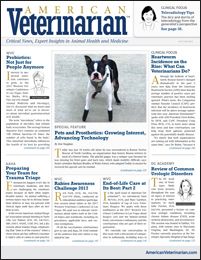Health Benefits of Functional Foods
A literature review reveals the effects of enriched foods on a number of health conditions affecting dogs and cats.

Dogs and cats are often seen as family members in pet-owning households. So, it’s no surprise that dog and cat owners have become increasingly interested in purchasing wholesome pet foods that provide more than just basic nutrition.
Functional foods go beyond meeting minimal nutritional needs. The American Dietetic Association describes functional foods as “whole, fortified, enriched or enhanced foods which have a potentially beneficial effect on health when consumed as part of a varied diet on a regular basis at effective levels.”
Examples of functional foods studied in human nutrition include fruits, vegetables, whole grains, prebiotics, and probiotics. The results of these studies have highlighted numerous benefits of functional foods, including better digestive function, improved satiety, and enhanced antioxidant activity.
Commercial dog and cat foods contain ingredients like dietary fiber and cereal grain that have nutritional benefits. However, according to the authors of a review recently published in Research in Veterinary Science, little research has been conducted to evaluate functional food activity in dogs and cats. Additional research is needed to better understand how diet can affect disease prevention and treatment in pets, the authors wrote. For their review, the authors performed an extensive literature search on the use of functional foods in dog and cat nutrition.
Functional Foods in Dogs
The authors identified several studies that evaluated functional foods in dogs. One study reported that a diet enriched with oligofructose reduced fecal ammonia and Clostridium perfringens concentrations.1 Other studies investigated functional foods’ effects on specific health issues.
Reproductive Performance
Antioxidant-enriched diets have been shown to improve reproductive performance. One study of 14 fertile male dogs reported increased semen motility and vitality with a diet supplemented with antioxidants.2
Cognitive Function
Several studies have investigated the effect of functional diets on canine cognitive health. Diets enriched with antioxidants and botanicals increased levels of brain-derived neurotrophic factor, which regulates neurogenesis and supports cognitive function.3,4 These diets also improved serotonin and dopamine levels and decreased the incidence of behavioral problems associated with cognitive dysfunction.5,6
Halitosis
Canine halitosis can have a negative effect on the relationship between and a dog and its owner. A functional diet fed to 16 dogs with chronic halitosis was evaluated for its effect on the concentrations of oral volatile sulfur compounds.7 The diet significantly reduced halitosis within 30 days and continued to have a noticeable effect several weeks after the diet was discontinued.
Chronic Otitis Externa
Chronic otitis externa treatment for dogs often involves topical combination therapy with an antimicrobial. Given the growing problem of antimicrobial resistance, functional diets have been evaluated as an alternative treatment option for dogs with chronic otitis externa.
In a study of 15 dogs with chronic otitis externa, a functional diet was fed in conjunction with medical therapy for 8 days, then alone for 82 days.8 Dogs experienced marked reductions in otitis externa signs, representing “a starting point for developing functional foods endowed with antibacterial activity,” the authors wrote.
Leishmaniasis
Functional diets with immunomodulatory activity have been evaluated in the treatment of leishmaniasis, a parasitic infection spread by sand flies. A study compared the effects of an immune modulating diet versus a standard diet in 20 dogs receiving medical therapy for leishmaniasis.9 Compared with the standard diet, the immune-modulating diet restored regulatory T-cell levels and decreased T-helper cell levels. Signs of leishmaniasis, including conjunctivitis and corneal keratinization, also improved with the immune-modulating diet.
Palatability
Although not a specific health issue, palatability can affect a dog’s food intake. One study determined that stabilized rice bran, a functional food with demonstrated health benefits in humans, can increase palatability of dog foods without compromising their nutrient digestibility or triggering an immune response.10
Functional Foods in Cats
Functional foods have also been evaluated in the treatment of feline health issues.
Chronic Diarrhea
In a study of 55 cats with chronic diarrhea, high- and low-fat diets improved fecal scores within the first week of dietary treatment. However, no significant differences in clinical responses were observed between the 2 diets, suggesting that fat content does not play a major role in feline chronic diarrhea management.11
Obesity
Feline obesity treatment involves reducing caloric content, which can be done by decreasing a diet’s energy density. In 1 study of 9 obese cats, researchers observed that increasing a diet’s quantity of apple pomace, a dietary fiber source, proportionally decreased the diet’s energy density.12 However, food intake decreased at the highest apple pomace percentage, indicating an upper limit to how much palatable fiber can be added to a cat’s diet.
Concerns Within The Pet Food Markey
Despite these demonstrated benefits, pet owners are skeptical of certain functional foods. For example, they tend to view corn and wheat negatively (low quality, poor nutritional value) even though these foods have antioxidant and anticancer activities. In contrast, perceptions are better for ingredients like oats and barley, which are seen as more wholesome.
Food safety is also a concern for the pet food market, given that contamination can cause nutritional deficiencies, even when a particular diet is properly formulated. Unfortunately, studying the effects of food contamination has been challenging because of the sheer number of potential contamination sources.
The authors mentioned consumer education as an additional concern, given that food labels can be difficult for pet owners to understand. More accurate food labels could help pet owners feel more informed when purchasing food for their pets.
Conclusion
A fuller understanding of functional pet foods will require more basic and applied nutritional research, the authors noted. Importantly, they believe that “the ultimate success of functional pet foods will depend on delivering bioactive components in a predictable, safe, and functional manner to effectively reduce the risk of disease and support the domestic animal’s body.”
Dr. Joanna Pendergrass received her DVM from the Virginia-Maryland College of Veterinary Medicine and completed a postdoctoral fellowship at Emory University’s Yerkes National Primate Research Center. Dr. Pendergrass is the founder and owner of JPen Communications, LLC, a medical communications company.
References:
- Flickinger EA, Schreijen EM, Patil AR, et al. Nutrient digestibilities, microbial populations, and protein catabolites as affected by fructan supplementation of dog diets. J Anim Sci. 2003;81:2008-2018.
- Ponzio PC, Canello S, Guidetti G, et al. Correlation between reproductive efficiency (semen quality and endocrine function) and dietary supplementation in dog breeding. Veterinaria. 2013;27:15-22.
- Sechi S, Chiavolelli F, Spissu N, et al. An antioxidant dietary supplement improves brain-derived neurotrophic factor levels in serum of aged dogs: preliminary results. J Vet Med. 2015;412501.
- Fahnestock M, Marchese M, Head E, et al. BDNF increases with behavioral enrichment and an antioxidant diet in the aged dog. Neurobiol Aging. 2012;33:546-554.
- Di Cerbo A, Sechi S, Canello S, et al. Behavioral disturbances: an innovative approach to monitor the modulatory effects of a nutraceutical diet. J Vis Exp. 2017;119.
- Sechi S, Di Cerbo A, Canello S, et al. Effects in dogs with behavioural disorders of a commercial nutraceutical diet on stress and neuroendocrine parameters. Vet Rec. 2017;180:18.
- Di Cerbo A, Pezzuto F, Canello S, et al. Therapeutic effectiveness of a dietary supplement for management of halitosis in dogs. J Vis Exp. 2015;101:e52717.
- Di Cerbo A, Centenaro S, Beribe F, et al. Clinical evaluation of an antiinflammatory and antioxidant diet effect in 30 dogs affected by chronic otitis externa: preliminary results. Vet Res Commun. 2016;40:29-38.
- Cortese L, Annunziatella M, Palatucci AT, et al. An immune-modulating diet increases the regulatory T cells and reduces T helper 1 inflammatory response in Leishmaniosis affected dogs treated with standard therapy. BMC Vet Res. 2015;11:295.
- Spears JK, Grieshop CM, Fahey Jr GC. Evaluation of stabilized rice bran as an ingredient in dry extruded dog diets. J Anim Sci. 2004;82:1122-1135.
- Laflamme DP, Xu H, Long GM. Effect of diets differing in fat content on chronic diarrhea in cats. J Vet Intern Med. 2011;25:230-235.
- Fekete S, Hullar I, Andrasofszky E, et al. Reduction of the energy density of cat foods by increasing their fibre content with a view to nutrients' digestibility. J Anim Physiol Anim Nutr. 2001;85:200-204.

Episode 67: Choosing trusted supplements
October 20th 2021In this episode of The Vet Blast Podcast, Dr Adam Christman chats with Dr Janice Huntingford about the latest insights into selecting the best supplements for your patients, including the importance of recommending and utilizing products that have a substantial amount of science and research behind them. (Sponsored by Vetoquinol)
Listen











